The cooling effects of tree cover
"RESEARCHING THE EFFECTS OF TREE COVER ON TEMPERATURE AT HARDKNOTT FOREST" by Ben Silver, Researcher & Hardknott Volunteer, October 2022.
During hot summer days that were all too common this year, many of us came to appreciate the value of trees in providing a cool space to rest during outdoor excursions. Whether it be a woodland or a single tree, on sunny days the air beneath the canopy is noticeably cooler.
There are two processes that are responsible for this cooling effect. The more obvious one is that a trees’ leaves create shade by absorbing and reflecting sunlight, but perhaps the more significant is through the process of transpiration. Transpiration is the evaporation of water from plant leaves. Plants need to allow water to escape as this lets them move nutrients absorbed through the roots up to the leaves. Furthermore, plants open stomata in their leaves to allow gases (e.g. oxygen, carbon dioxide) to be exchanged.
When water evaporates, it absorbs latent heat, sucking energy from its immediate environment. This is the same process by which sweating cools our skin. Trees perform this process very efficiently, with their deep roots able to continue the process of transpiration long after rain, and their large canopies providing a huge surface area for water to evaporate from.
Research at Hardknott Forest is shedding light on the ability of a regenerating forest to recover this important ecosystem service. Much of the research value of Hardknott stems from its previous management as forestry. As different stands of trees have been felled in different years, we can build a chronology of forest regeneration data from areas across the site, from new patches of regen to those cleared 20 years ago. Taking advantage of this “space-for-time" substitution, we placed six temperature and humidity monitors around the site. Monitors were placed in young, medium and mature (Regen 1, 2 and 3) areas of regeneration, as well as Great Wood (mature oak forest), a stand of mature conifer (“Norway Spruce”), and an open field (“Cat Bield”) to act as a control (Figure 1).

Figure 1 Locations of the monitoring sites at Hardknott Forest. DEFRA LIDAR canopy height data is shown for each site.

Figure 2 An iButton monitor in the field
The monitors were set up in spring, and kept in place until autumn, so that temperatures could be monitored throughout summer. We used ‘iButton’ monitors that record both temperature and humidity, and placed them on 40cm posts (Figure 2), facing north, and shaded by a lid. We chose a sampling rate of 30 minutes; a compromise between capturing the changeable weather and the limited memory available on the iButtons.
Figure 3 shows the average daily temperature throughout the summer. The two heatwaves stand out as clear peaks. We were “lucky” to have been monitoring the temperature during such a record-breaking summer! The maximum temperatures are even more dramatic. In the next steps of our analysis we will verify the temperatures recorded by our sensors against a nearby official weather station.

Figure 3: Average daily temperature throughout study
Figure 4 shows the difference between the sites at different times of day. As expected, the areas with denser tree cover have cooler temperatures during daylight hours. To quantify the cooling effect in the different levels of forest density, we compared the temperature in the open field, Cat Bield, to the temperature in forested areas (Figure 5). The results show that as temperatures get higher, the trees are able to cool their surrounding environment to greater degree compared with the temperature in an open field. We also see that the trees with the greatest ability to cool their environment is the stand of Norway Spruce, which during the hottest temperatures are around 15°C cooler at ground level. Less expected is that the area of the most mature regen (Regen 3) appears to have a greater cooling capacity than in the mature oak woodland (Great Wood). Perhaps this is due to the greater density of the former area, which is dominated by birches. However, as always, there are other variables influencing the result, which we could not control for. Different areas of Hardknott may have different microclimates, soil wetness etc. that could play their part in causing differences between the monitoring sites.
For future work, we plan to gather more data by repeating the study next year, perhaps using more monitoring sites to make the results more reliable. Another interesting analysis would be to look into whether the trees’ ability to provide cooling was damaged by the extreme heat. Trees can drop their leaves due to stress which would damage their ability to transpire, and drought conditions also limit the amount of water available.
These results demonstrate how important it is to have trees in the landscape, to provide areas of refuge for both humans and animals. At much larger scales, trees have been shown to have a cooling effect on cities, countries and even entire continents. Along with absorbing carbon, providing habitats and cleaning the air (need I go on?), cooling is one of the ‘superpowers’ that makes afforestation a key part of both adapting to and mitigating climate change.

Figure 4: Diurnal temperatures

Figure 5: Smoothed average cooling relative to Cat Bield
